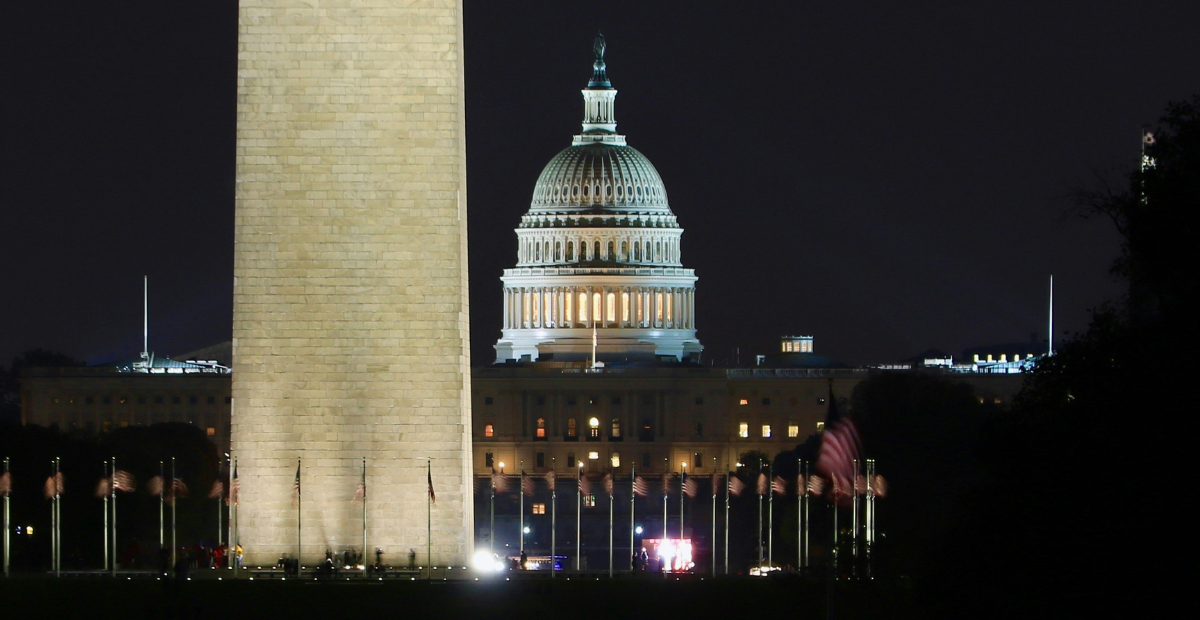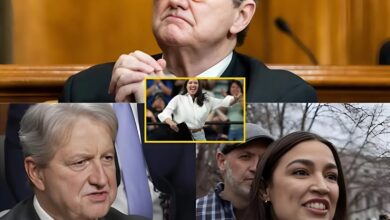HH. “I’m not a king,” said President Donald Trump aboard Air Force One on Monday, Oct. 20. “I work my a** off to make our country great. That’s all it is.” This was said following many nationwide protests over the weekend, dubbed the “No Kings” protests. Among those who supported the rallies was Sen. Chuck Schumer, D-NY, who has voted 10 times against a Republican-backed stopgap measure to reopen the government since the government shutdown began on Oct. 1.Watch Trump speak on whether he’s a king or not, and keep up with the government shutdown, at the link in the first comment

On Wednesday, Oct. 1, 2025, the United States government entered a shutdown for the first time in six years. Here, the United States Capitol can be seen, with the Washington Monument — which will be closed to the public during the shutdown — in the foreground. (Photo credit: Hongbin / Unsplash)
This article was updated on Monday, October 20.
“No Kings” Protests Coincide With Government Shutdown
Today, October 20, is the 20th day of the government shutdown, which the United States government entered as the clock struck midnight on October 1.
Framed by the White House as the “Democrat Shutdown,” this is the first government shutdown in six years, and House Speaker Mike Johnson (R-LA) noted during a press conference on October 20 that this is now the longest full government shutdown in American history.
“When you look at it carefully, it is already the longest full shutdown of all time,” said Johnson, noting that the shutdowns in 2018 and in 1995 were both longer, but were only partial shutdowns.
Johnson went on to say, “This is the first time in history that any party has had the audacity to shut down the government over a totally clean, non-partisan continuing resolution. This is a political stunt.”
Continuing, Johnson went on to speak of a different “political stunt,” acknowledging the “No Kings” protests which were held over the weekend in many major cities across the country.
These protests were supported by Sen. Chuck Schumer (D-NY), who joined demonstrators on the streets of New York on October 18.
“Today’s No Kings rallies are an affirmation of what America is all about,” Schumer said on X, formerly Twitter. “We are a democracy. We have no kings, despite the fact that Trump has even said he wants to become one.”
To this, Johnson said, “They called it ‘the No Kings rally,’ but the great irony, of course … was if President Trump was a king, the government would be open. If President Trump was a king, he would’ve closed the national parks and the National Mall so that they couldn’t have had the rally out here.”
When asked about the No Kings protests by the press in the early morning of October 20, President Donald Trump replied, “I’m not a king. I work my a** off to make our country great. That’s all it is.”
Watch Trump’s statement on not being a king, here:

About The Shutdown
This shutdown was triggered as Republicans and Democrats in the Senate failed to reach at least 60 votes on either of their proposals to keep the government funded into the new fiscal year.
As the shutdown continues, there are many concerns about active military personnel receiving pay, but President Donald Trump notified the press of a possible solution for the meantime.
While in a meeting with Argentine President Javier Milei on October 14, Trump took a question from the press about military pay, and he said, “I actually have a man who, he’s a very wealthy person … a donor, a great gentleman, and he said, ‘If there’s any money necessary shortfall for the paying of the troops, that I will pay it.’”
There is no word yet on who this individual is, but a vote held on October 16 to ensure troops would be paid during the shutdown failed, 50-44.
Watch the comments made by Trump, here:
On October 20, the Senate is expected to vote on reopening the government for the 12th time since the shutdown began. Votes have been conducted almost daily on week days, with the Democrats sticking to their proposal and the Republicans sticking to the continuing resolution.
The Democrats’ proposal includes healthcare subsidies that Republicans oppose as they would direct $200 billion in taxpayer funds to illegal migrants. This proposal failed in a vote of 46-52.
The Republican-backed continuing resolution introduces no new measures, being a clean stopgap resolution to continue funding the government from the previous budget.
Voting on partisan lines has led to consistent failures to reach the 60-vote threshold required for approval.
Despite the shutdown, the Senate has managed to approve over 100 Trump appointments and pass the nation’s defense budget, which is over $915 billion.
Background
“Well, the Democrat Caucus here in town, in the Senate, has chosen to shut down the government over a clean nonpartisan funding bill,” said Senate Majority Leader John Thune (R-SD) at a press conference in the evening of September 30. “We didn’t ask Democrats to swallow any new Republican policies.”
Before the shutdown, Republicans proposed a continuing resolution which would have funded the government for seven more weeks to allow time for further deliberation.
Continuing, Thune stated, “We didn’t add partisan riders. We simply asked Democrats to extend funding levels to allow the Senate to continue the bipartisan appropriations work that we started.”
Democrats are largely holding firm for a spending plan which would extend expiring subsidies for the Affordable Care Act, also known as Obamacare.
This Republican-backed spending plan originated in the House of Representatives, where it passed 217-212, with two Republicans (Thomas Massie, R-KY; and Victoria Spartz, R-IN) opposing it and one Democrat (Jared Golden, D-ME) supporting it.
Without the Senate’s approval, the plan to keep the government afloat through November 21 has failed.
Watch Senate Majority Leader John Thune speak about the shutdown, here:
Caught In Deadlock
On September 29, President Donald Trump was asked about the then-looming government shutdown, to which he said, “The Democrats are crazed. They don’t know what they’re doing.”
A significant Republican holdout is Sen. Rand Paul (R-KY), who says the Republican plan is not in keeping with fiscally conservative principles.
Watch Rand discuss his opposition to both the Republican and Democrat plans, here:
While the government is shutdown, Sen. Rick Scott (R-FL) is pushing for an act close to his heart to be made into law.
“Since I got to Washington in 2019, I have been fighting to pass my No Budget, No Pay Act, which holds members of Congress accountable for passing a budget or forgoing their pay,” said Scott on X, adding, “Workers across America don’t get paid when they don’t do their jobs. Why should Congress be any different?”
Still, Scott holds that it is the Democrats who are responsible for the budget not moving forward, writing:
Meeting for a press conference outside the Capitol, overlooking the National Mall, in the morning of October 1, House Speaker Mike Johnson (R-LA) said , “We’re overlooking the National Mall, a beautiful site that a lot of the American people will not be able to experience today.”
Visitors to D.C. will not be able to enter the U.S. Capitol today, he said, adding, “That’s because the Democrats followed through with their threat to shut down the United States government.”
Further, he said, “As we speak here this morning, there are hundreds of thousands of federal workers who are getting their furlough notices. Nearly half of our civilian workforce is getting sent home. These are hardworking Americans who work for our federal government.”
Watch the full Republican press conference, here:

Look through the Republican plan that the House approved but the Senate did not, here.
At an Oct. 2 press conference, House Majority Leader Rep. Steve Scalise (R-LA) spoke on the significance of the continuing resolution, saying:
“We know that there is a very straightforward way out of this, and that is for Senate Democrats to join with Senate Republicans and vote for the bill that opens up the government and allows negotiations to continue. Surely, by opening up the government again, it doesn’t resolve all of our differences, but it allows us to negotiate without [Sen.] Chuck Schumer holding the American people hostage.”
Democrats largely held firm in their opposition to the continuing resolution, saying the government’s budget would need to extend expiring subsidies for the Affordable Care Act, also known as Obamacare.
On Oct. 3, House Speaker Mike Johnson pointed to the reason for Republican’s disapproval of extending these subsidies, saying that $192 billion in the Democrat-proposed continuing resolution would go toward healthcare for illegal migrants.
What Does The Shutdown Mean?
The last time the government went through a shutdown was in December of 2018 through January of 2019, during which the government was shut down for its longest stretch of time in U.S. history: 35 days.
For however long this 2025 shutdown lasts, many government services will still remain active.
Social Security checks will still be sent out, air traffic control will not be impacted, and student loans will still be administered.
Services such as SNAP and WIC will continue regular operations as funding remains.
Federal courts will also remain open.
Still, there are notable exceptions.
Many National Parks will remain open as funding remains, but emergency services to those areas will be limited and spaces requiring staffing, like the interior of the Washington Monument or other sites with visitor centers, will be closed to the public.
Opportunities for small business loans are also, for the most part, closed.
Veterans assistance is halted as well.
Additionally, military and civilian personnel, including border patrol agents, will remain on active duty, but their pay will be delayed until a resolution is reached.
This is a developing story.


